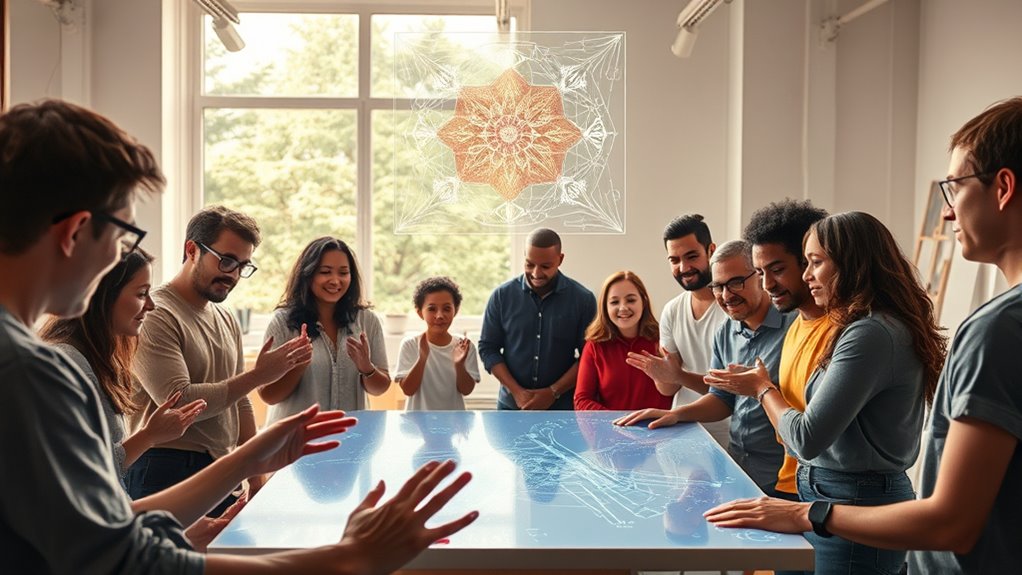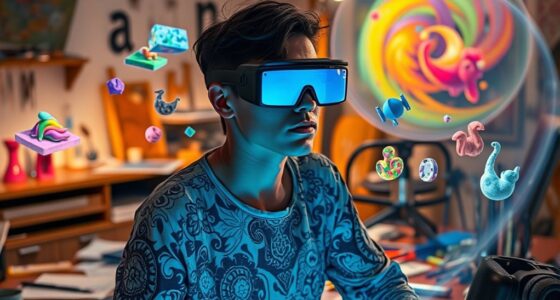To avoid creative homogenization in human–AI collaboration, actively curate diverse AI outputs and provide ongoing, nuanced feedback to guide originality. Encourage multiple perspectives, challenge assumptions, and set boundaries to keep humans in control. Use metrics to monitor diversity and continually adjust your approach. Incorporate brainstorming techniques and iterative evaluations to foster innovation and prevent predictability. Stay mindful of biases in training data. Exploring further reveals how adaptive models and strategic collaboration can sustain long-term creative diversity.
Key Takeaways
- Actively curate and diversify AI training data to prevent bias and promote varied creative outputs.
- Incorporate regular human feedback to guide AI toward novel and less predictable ideas.
- Set boundaries for AI use, maintaining human oversight to retain creative control.
- Use iterative evaluation metrics like originality and semantic distance to identify and counter homogenization.
- Foster a collaborative environment that encourages diverse perspectives and challenge assumptions regularly.
The Dynamics of Diversity in Human-AI Creative Teams
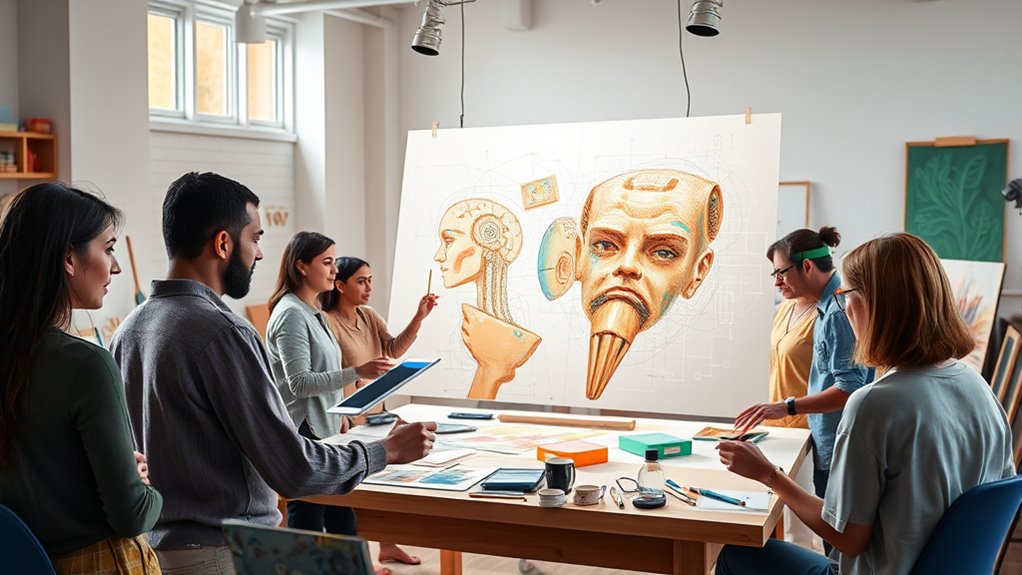
The dynamics of diversity in human-AI creative teams are shaped by how both parties contribute and evolve over time. Initially, AI-only networks tend to display higher diversity, but this often diminishes as models become influenced by their training data, leading to homogenization. Conversely, human-AI teams typically start with lower diversity but increase it through iterative collaboration, as humans introduce fresh ideas and challenge AI outputs. Your active engagement and feedback help guide AI toward novel directions, fostering greater originality. Over successive interactions, this evolving relationship encourages diversity, balancing AI’s pattern recognition with human creativity. By understanding these dynamics, you can strategically leverage AI to expand your creative horizons while maintaining the unique perspectives essential for innovative design. Additionally, vetted AI models are more likely to provide diverse and reliable outputs, ensuring that the creative process remains robust and dynamic.
Recognizing and Mitigating AI-Induced Homogenization

You need to be aware that AI training data often introduces biases that lead to homogenized outputs, reducing diversity in creative projects. To foster innovation, it’s essential to implement strategies that address these biases and promote varied ideas. By actively recognizing and counteracting homogenization, you can guarantee your collaborations remain fresh and original. Exploring diverse designs in indoor gardening, such as unique planters and eco-friendly options, can serve as a metaphor for encouraging originality in AI-assisted creativity.
Addressing Training Data Bias
Addressing training data bias is essential because AI models often reflect the patterns and limitations inherent in their datasets, leading to homogenized and predictable outputs. To combat this, you should diversify training data sources, including less-represented perspectives and creative styles. Regularly evaluate AI outputs for signs of bias or over-reliance on common patterns, and adjust data collection accordingly. Incorporating human oversight during training helps identify and correct biased tendencies. Additionally, employing techniques like data augmentation or counterfactual examples can challenge the model to generate more varied ideas. Encouraging transparency about data sources and limitations also guides better oversight. By actively managing training data, you can foster more diverse and innovative AI contributions, reducing homogenization and supporting unique creative collaboration. Recognizing the importance of emotional support can also help ensure that AI outputs consider empathetic and human-centered considerations.
Promoting Creative Diversity
Recognizing and mitigating AI-induced homogenization is essential for maintaining originality and diversity in creative outputs. To promote creative diversity, you should actively balance AI suggestions with human input, encouraging unique perspectives. Incorporate techniques that challenge AI biases, like varied training data and diverse prompts, to prevent repetitive patterns. Regularly assess creativity metrics such as originality and semantic distance, adjusting your approach accordingly. Foster an environment where human innovation thrives alongside AI-generated ideas, emphasizing the value of novelty. Use feedback mechanisms to refine outputs and avoid fixation bias. Developing adaptive collaboration models that respond to performance insights can further enhance diversity. Additionally, understanding Ethical Hacking principles can help ensure that AI tools are used responsibly and securely in creative processes. Ultimately, your goal is to create a dynamic synergy, ensuring AI supports rather than constrains creative exploration and variety.
Impact of Training Data Bias on Creative Outputs
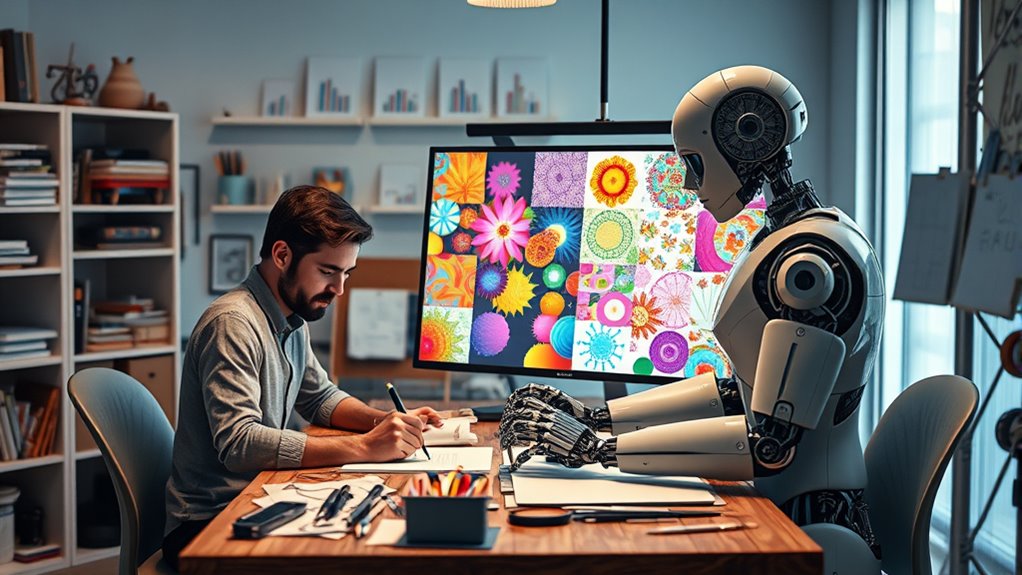
Training data bias considerably impacts the diversity and originality of creative outputs generated by AI systems. When your AI is trained on skewed or limited data, it tends to produce repetitive, predictable ideas that reflect those biases. This homogenization can stifle innovation, as the AI’s outputs become less varied and more aligned with common patterns. You might notice that AI-generated designs or concepts lack uniqueness, often echoing familiar themes rather than exploring novel territory. Over time, this bias reinforces existing stereotypes and narrow perspectives, reducing the overall creative spectrum. To counteract this, you need to actively seek diverse datasets, implement bias-mitigation techniques, and encourage human input that challenges the AI’s tendencies. These steps help maintain the freshness and originality essential for meaningful human-AI collaboration. Recognizing figurative language techniques in AI outputs can also reveal underlying biases and deepen the understanding of creative expression.
Strategies to Balance Human and Machine Contributions

Balancing human and machine contributions is key to maintaining diversity and fostering innovation in collaborative creative processes. To achieve this, you should actively curate AI outputs, encouraging human input to challenge and refine ideas. Incorporate feedback mechanisms that allow you to assess AI-generated suggestions, promoting diverse perspectives. Set clear boundaries for AI use, ensuring humans retain control over the creative direction. Regularly evaluate outputs using metrics like originality and novelty to detect homogenization early. Experiment with collaboration models that emphasize human intuition and creativity alongside AI suggestions. Educate yourself on how to leverage AI strengths without over-relying on them. Additionally, understanding the safety features of AI tools helps prevent unintended homogenization of ideas. By consciously blending human insight with machine capabilities, you can foster unique ideas and prevent homogenized results in your creative projects.
Enhancing Originality Through Collaborative Feedback Loops
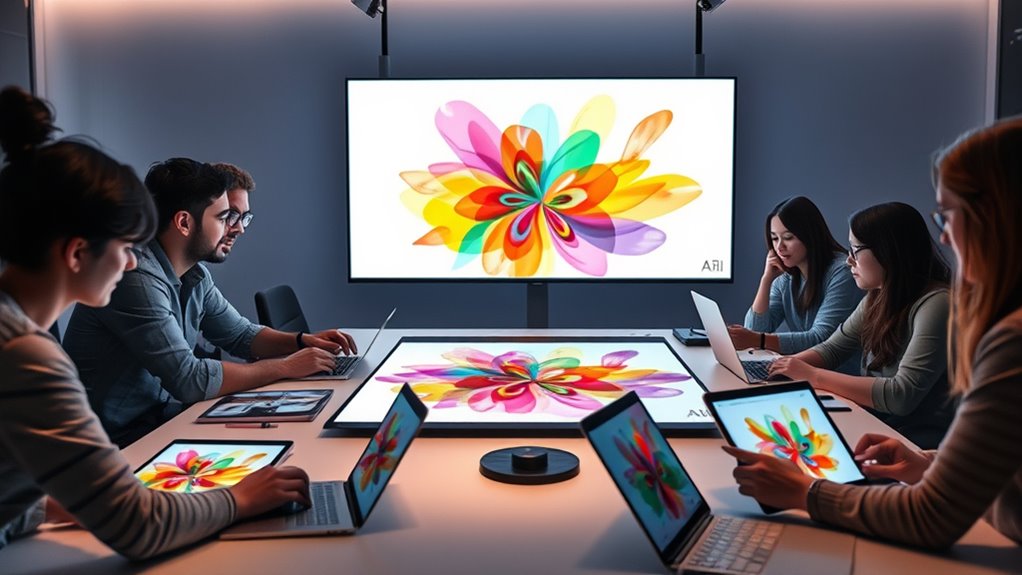
You can boost originality by using iterative idea refinement, where ongoing feedback helps improve and diversify concepts. Encouraging diverse perspectives guarantees that collaboration doesn’t become homogenized, keeping creative outputs fresh. Monitoring creativity metrics allows you to objectively assess progress and adjust feedback loops to maximize innovation. Incorporating artistic expression techniques can further stimulate unique ideas and prevent stagnation.
Iterative Idea Refinement
Iterative idea refinement is a crucial process in human–AI collaboration that leverages continuous feedback to enhance originality. As you work with AI, you provide input, evaluate outputs, and suggest improvements, creating a feedback loop that sharpens ideas over time. This process allows you to identify and eliminate predictable or homogenized elements introduced by AI, fostering unique and innovative concepts. By iteratively refining ideas, you can challenge initial AI suggestions, encouraging deeper exploration and more diverse solutions. Regular feedback helps prevent fixation bias and guides the AI toward producing outputs aligned with your creative goals. Additionally, understanding key concepts such as projector technology can inform more nuanced feedback to improve the AI’s outputs. This collaborative cycle ultimately strengthens originality, ensuring that the final ideas are more inventive and less susceptible to homogenization caused by AI’s training data.
Encouraging Diverse Perspectives
Encouraging diverse perspectives in human–AI collaboration can especially boost originality by broadening the range of ideas and approaches considered. You can do this by actively seeking input from different sources, backgrounds, and expertise, ensuring the AI is exposed to varied data and viewpoints. Incorporate feedback loops that challenge assumptions and prompt alternative solutions, preventing the project from converging on familiar or dominant ideas. Encourage human collaborators to question AI suggestions and explore unconventional options. This iterative process helps break down cognitive biases and fosters creative tension, leading to more innovative outcomes. Additionally, understanding sector-specific private placements can provide context for applying diverse strategies and insights in collaborative projects. By intentionally cultivating a variety of perspectives, you create an environment where both human intuition and AI-generated insights contribute to richer, more original designs.
Monitoring Creativity Metrics
Monitoring creativity metrics is essential for guiding effective human–AI collaboration and ensuring that originality is maintained throughout the design process. By regularly evaluating metrics like originality, fluency, and semantic distance, you can identify when outputs become too homogeneous or predictable. These measurements provide tangible feedback, helping you adjust your interactions with AI tools to foster diversity. Incorporate iterative evaluations into your workflow, prompting AI to generate more varied ideas or encouraging human input when metrics indicate convergence. This ongoing monitoring creates a feedback loop that balances innovation with consistency. Additionally, understanding the performance of vacuum cleaners on different surfaces can inform adjustments in design iterations to enhance product uniqueness. Ultimately, tracking creativity metrics helps you detect homogenization early, refine your collaborative strategies, and sustain the novelty and uniqueness crucial for truly innovative designs.
Techniques for Encouraging Human Innovation

To foster human innovation in collaborative settings, it’s crucial to implement techniques that stimulate original thinking and challenge existing cognitive patterns. Encourage brainstorming sessions that emphasize quantity over quality, allowing ideas to flow freely without immediate judgment. Use prompts that push you beyond conventional perspectives, such as “What if?” questions or hypothetical scenarios. Incorporate diverse viewpoints by actively seeking input from individuals with different backgrounds, which broadens your creative lens. Challenge assumptions regularly to break mental fixedness, and experiment with combining unrelated concepts to spark novel ideas. Emphasize reflection and iteration, giving yourself space to refine and build upon initial concepts. These techniques promote originality, maintain diversity, and prevent homogenization in your collaborative creative process.
Developing Adaptive Models for Sustainable Creativity

Building adaptive models for sustainable creativity involves designing systems that can evolve in response to changing inputs, feedback, and context. These models continuously learn from user interactions, adjusting their outputs to promote originality and diversity. To achieve this, you should focus on:
- Incorporating real-time feedback loops to refine AI suggestions and prevent homogenization
- Developing flexible algorithms that adapt to different creative domains and individual styles
- Balancing exploration and exploitation to foster innovation without drifting into predictable patterns
Measuring Creativity: Metrics and Best Practices

Measuring creativity in human-AI collaboration requires clear, reliable metrics that capture both the novelty and quality of ideas. You should focus on metrics like originality, fluency, and semantic distance to assess how innovative and diverse outputs are. Regularly evaluating these metrics helps identify patterns of homogenization and guides adjustments in your process. Use quantitative measures for idea diversity and qualitative assessments for relevance and coherence. Combining multiple metrics provides a holistic view of creative performance. It’s important to benchmark AI-generated ideas against human outputs and monitor changes over time. Best practices include setting clear evaluation criteria, involving diverse evaluators, and continuously refining your metrics based on collaborative feedback. This approach ensures you maintain a balance between originality and quality in your creative outputs.
Future Directions for Maintaining Diversity in AI-Enhanced Design
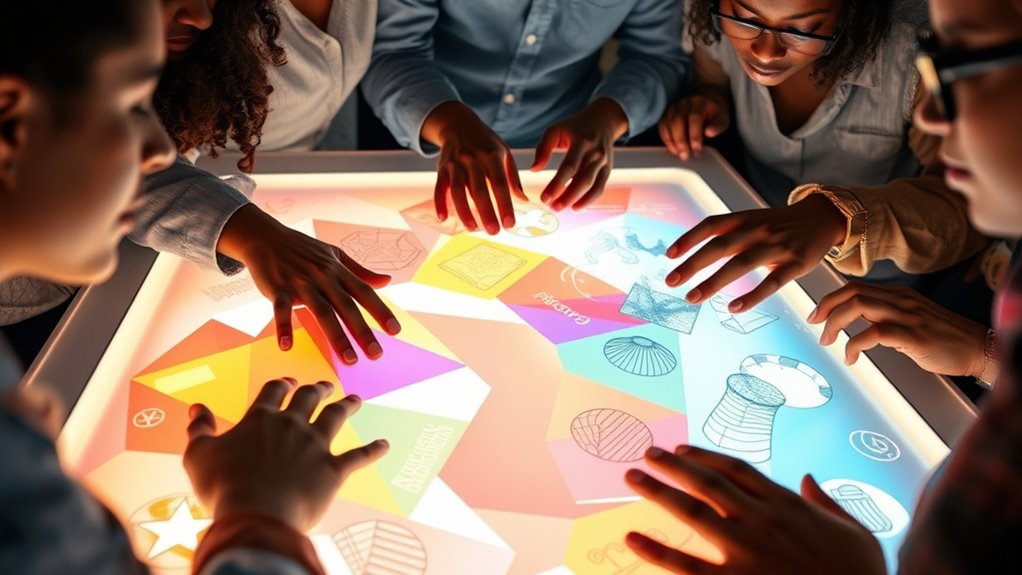
Maintaining diversity in AI-enhanced design requires innovative strategies that counteract homogenization caused by training data biases and AI’s tendency toward predictable outputs. To keep creativity vibrant, you should explore adaptive collaboration models that adjust based on feedback, fostering continuous innovation. Encouraging human input and experimentation remains essential to introduce fresh perspectives that AI might overlook. Regularly evaluating creativity metrics helps identify patterns of homogenization, enabling targeted interventions. Additionally, developing AI tools tailored for specific creative domains ensures more diverse outputs aligned with unique project needs. By combining these approaches, you create a balanced ecosystem where AI complements human ingenuity without compromising originality.
Foster diverse AI design through adaptive collaboration, human experimentation, targeted tools, and ongoing creativity evaluation.
- Implement feedback loops to refine AI outputs
- Develop domain-specific AI tools for diversity
- Promote human experimentation and innovation
Frequently Asked Questions
How Can AI Models Be Designed to Promote Sustained Diversity Over Time?
To promote sustained diversity over time, you should design AI models that incorporate mechanisms for ongoing feedback and adaptability. Use techniques like bias mitigation and encourage human input to diversify outputs. Regularly evaluate creativity metrics to identify homogenization signs, and adjust algorithms accordingly. By balancing AI suggestions with human innovation, you can foster unique ideas, prevent fixation, and guarantee your models evolve to support long-term creative diversity.
What Ethical Concerns Arise From Homogenization in Ai-Generated Creative Outputs?
Homogenization in AI-generated creativity raises ethical concerns about stifling diversity and perpetuating biases. You might worry that relying too heavily on AI could diminish human originality, leading to predictable, less authentic outputs. This risks marginalizing minority perspectives and reinforcing stereotypes embedded in training data. To guarantee ethical collaboration, you must prioritize transparency, diversify training datasets, and actively promote human innovation, safeguarding the richness of creative expression.
How Does User Expertise Influence the Effectiveness of Human-Ai Creative Collaboration?
Your expertise markedly impacts how effective your collaboration with AI becomes. If you’re a novice, AI can boost your creativity and help you develop ideas faster. As you gain experience, you’ll better guide AI outputs, fostering more original and diverse results. However, if you rely too heavily on AI without critical input, homogenization risks increase. By actively engaging and providing nuanced feedback, you guarantee your expertise enhances creativity and maintains originality.
Can Real-Time Feedback Improve Ai’s Contribution to Maintaining Originality?
Like a sculptor chiseling stone, your real-time feedback shapes AI’s role in sparking originality. It guides the AI away from predictable patterns, much like a compass steering through fog. By actively correcting and encouraging novel ideas, you help the AI break free from homogenization, ensuring creative outputs stay fresh and diverse. This dynamic interaction fosters a vibrant creative flow, preventing AI’s contributions from becoming echoes of the familiar.
What Role Do Cultural Differences Play in Ai-Human Creative Partnerships?
Cultural differences shape your AI-human creative partnerships by influencing how ideas are generated, interpreted, and valued. You need to guarantee your AI understands diverse cultural perspectives to foster inclusivity and originality. By actively incorporating cultural nuances, you help prevent homogenization, encouraging unique insights and creative diversity. Adjusting AI algorithms to reflect various cultural contexts allows you to create more authentic, globally relevant collaborations that enrich the creative process.
Conclusion
To truly harness the potential of human-AI collaboration, you must prioritize diversity and originality. Don’t let the fear of homogenization hold you back—your unique perspective is essential. By actively fostering creative variety and challenging biases, you can guarantee that AI becomes a tool for genuine innovation, not conformity. Embrace these strategies, and you’ll create works that inspire, surprise, and stand the test of time. Your creativity can shape a richer, more diverse future.
